Investigating the Interplay of Tourism and Society at Level 4
VerifiedAdded on 2023/06/04
|8
|2827
|192
Essay
AI Summary
This essay explores the multifaceted relationship between tourism and society, highlighting both the positive and negative impacts of tourism on communities and economies. It investigates key concepts such as the Tourism Life Cycle model, which explains the evolution of tourist destinations through stages like exploration, involvement, development, consolidation, stagnation, and decline or rejuvenation. The essay discusses how tourism generates employment, preserves local traditions, and stimulates economic growth, while also addressing potential drawbacks like seasonal job instability, environmental damage, cultural disruption, and increased costs for locals. Furthermore, it examines tourist behavior, motivations (intrinsic and extrinsic), and the influence of cultural differences on tourism. The conclusion emphasizes the importance of understanding this dynamic relationship for sustainable economic improvement, with tourism acting as a catalyst for both development and potential challenges for societies worldwide. Desklib provides further resources and solved assignments on this topic for students.
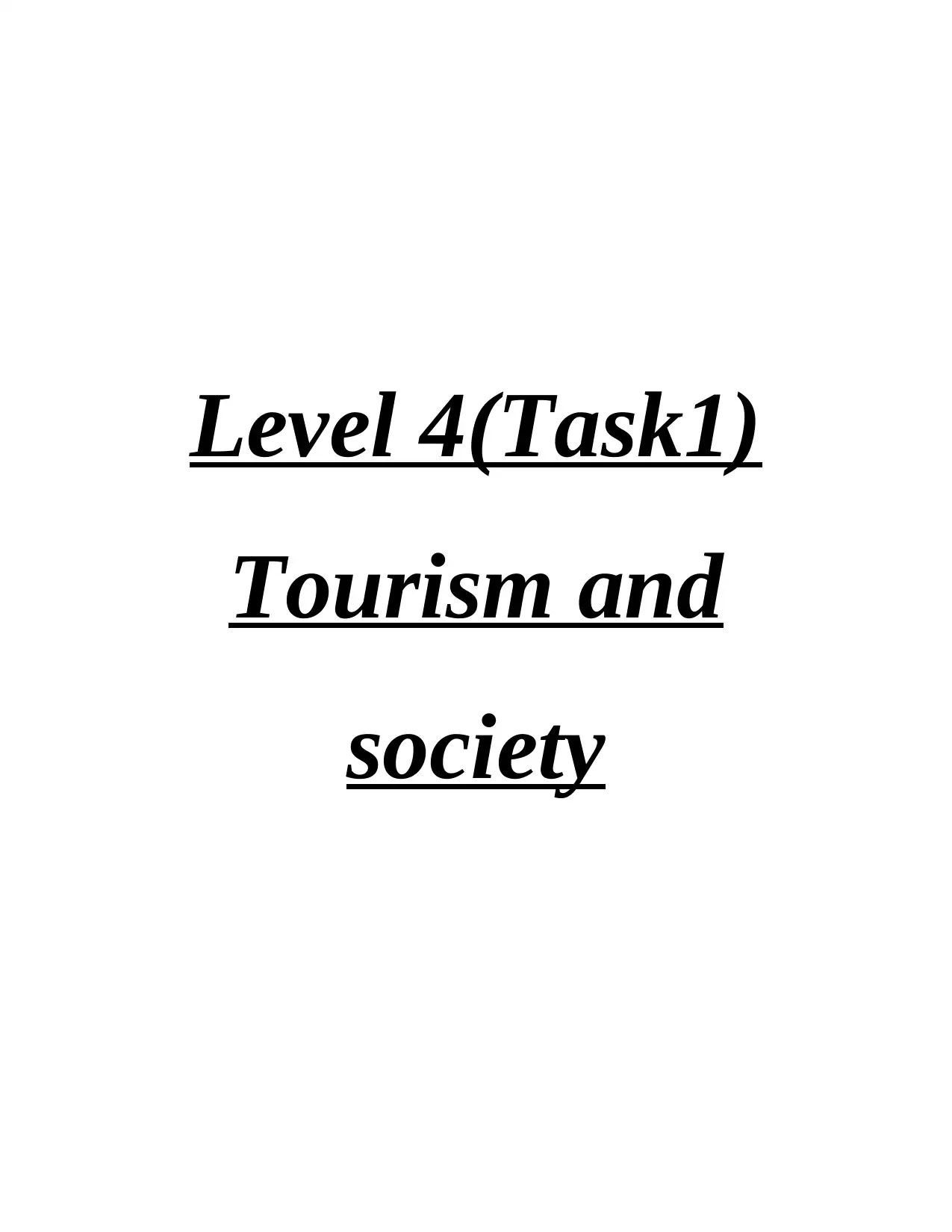
Level 4(Task1)
Tourism and
society
Tourism and
society
Paraphrase This Document
Need a fresh take? Get an instant paraphrase of this document with our AI Paraphraser

Contents
INTRODUCTION ..........................................................................................................................1
MAIN BODY...................................................................................................................................1
CONCLUSION................................................................................................................................4
REFERENCES................................................................................................................................6
INTRODUCTION ..........................................................................................................................1
MAIN BODY...................................................................................................................................1
CONCLUSION................................................................................................................................4
REFERENCES................................................................................................................................6
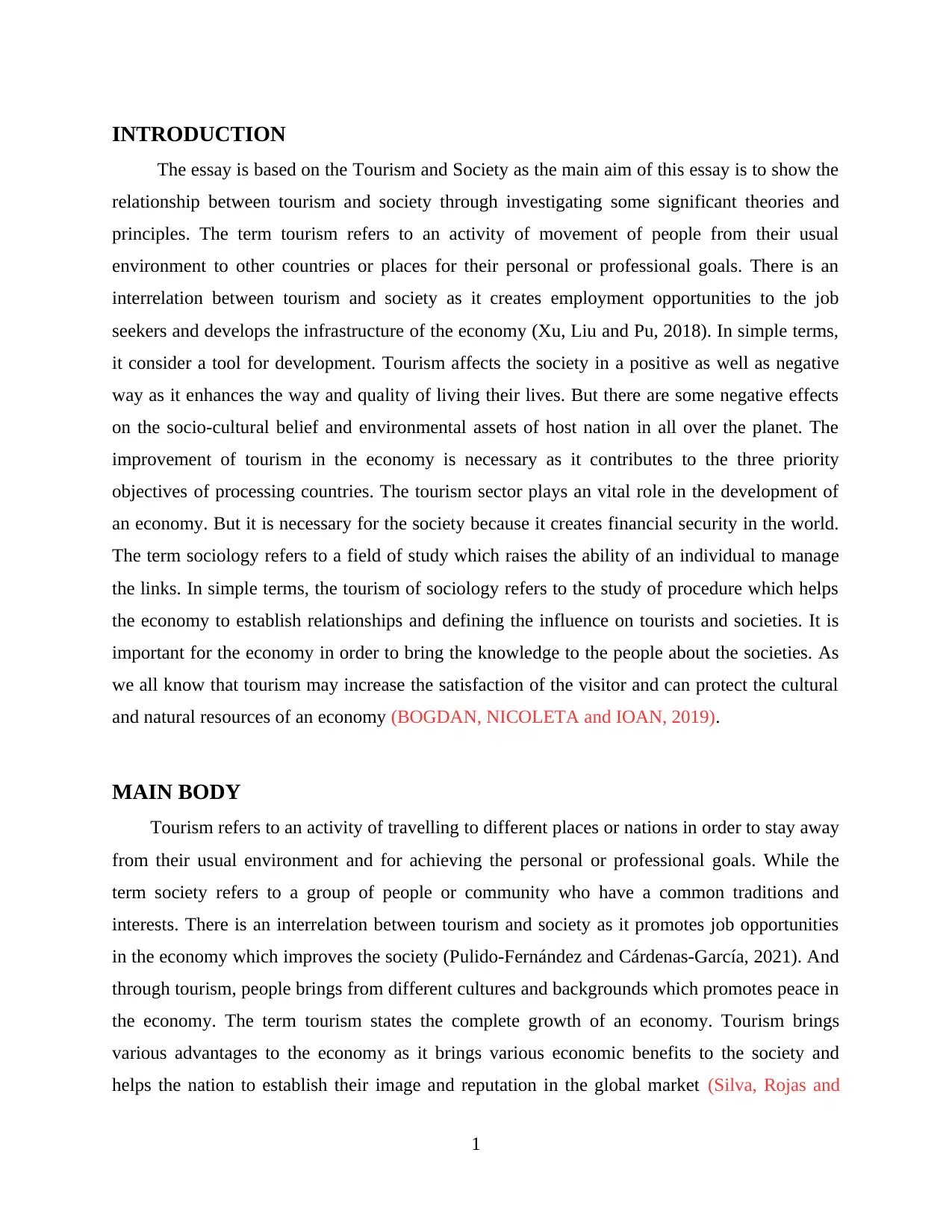
INTRODUCTION
The essay is based on the Tourism and Society as the main aim of this essay is to show the
relationship between tourism and society through investigating some significant theories and
principles. The term tourism refers to an activity of movement of people from their usual
environment to other countries or places for their personal or professional goals. There is an
interrelation between tourism and society as it creates employment opportunities to the job
seekers and develops the infrastructure of the economy (Xu, Liu and Pu, 2018). In simple terms,
it consider a tool for development. Tourism affects the society in a positive as well as negative
way as it enhances the way and quality of living their lives. But there are some negative effects
on the socio-cultural belief and environmental assets of host nation in all over the planet. The
improvement of tourism in the economy is necessary as it contributes to the three priority
objectives of processing countries. The tourism sector plays an vital role in the development of
an economy. But it is necessary for the society because it creates financial security in the world.
The term sociology refers to a field of study which raises the ability of an individual to manage
the links. In simple terms, the tourism of sociology refers to the study of procedure which helps
the economy to establish relationships and defining the influence on tourists and societies. It is
important for the economy in order to bring the knowledge to the people about the societies. As
we all know that tourism may increase the satisfaction of the visitor and can protect the cultural
and natural resources of an economy (BOGDAN, NICOLETA and IOAN, 2019).
MAIN BODY
Tourism refers to an activity of travelling to different places or nations in order to stay away
from their usual environment and for achieving the personal or professional goals. While the
term society refers to a group of people or community who have a common traditions and
interests. There is an interrelation between tourism and society as it promotes job opportunities
in the economy which improves the society (Pulido-Fernández and Cárdenas-García, 2021). And
through tourism, people brings from different cultures and backgrounds which promotes peace in
the economy. The term tourism states the complete growth of an economy. Tourism brings
various advantages to the economy as it brings various economic benefits to the society and
helps the nation to establish their image and reputation in the global market (Silva, Rojas and
1
The essay is based on the Tourism and Society as the main aim of this essay is to show the
relationship between tourism and society through investigating some significant theories and
principles. The term tourism refers to an activity of movement of people from their usual
environment to other countries or places for their personal or professional goals. There is an
interrelation between tourism and society as it creates employment opportunities to the job
seekers and develops the infrastructure of the economy (Xu, Liu and Pu, 2018). In simple terms,
it consider a tool for development. Tourism affects the society in a positive as well as negative
way as it enhances the way and quality of living their lives. But there are some negative effects
on the socio-cultural belief and environmental assets of host nation in all over the planet. The
improvement of tourism in the economy is necessary as it contributes to the three priority
objectives of processing countries. The tourism sector plays an vital role in the development of
an economy. But it is necessary for the society because it creates financial security in the world.
The term sociology refers to a field of study which raises the ability of an individual to manage
the links. In simple terms, the tourism of sociology refers to the study of procedure which helps
the economy to establish relationships and defining the influence on tourists and societies. It is
important for the economy in order to bring the knowledge to the people about the societies. As
we all know that tourism may increase the satisfaction of the visitor and can protect the cultural
and natural resources of an economy (BOGDAN, NICOLETA and IOAN, 2019).
MAIN BODY
Tourism refers to an activity of travelling to different places or nations in order to stay away
from their usual environment and for achieving the personal or professional goals. While the
term society refers to a group of people or community who have a common traditions and
interests. There is an interrelation between tourism and society as it promotes job opportunities
in the economy which improves the society (Pulido-Fernández and Cárdenas-García, 2021). And
through tourism, people brings from different cultures and backgrounds which promotes peace in
the economy. The term tourism states the complete growth of an economy. Tourism brings
various advantages to the economy as it brings various economic benefits to the society and
helps the nation to establish their image and reputation in the global market (Silva, Rojas and
1
⊘ This is a preview!⊘
Do you want full access?
Subscribe today to unlock all pages.

Trusted by 1+ million students worldwide
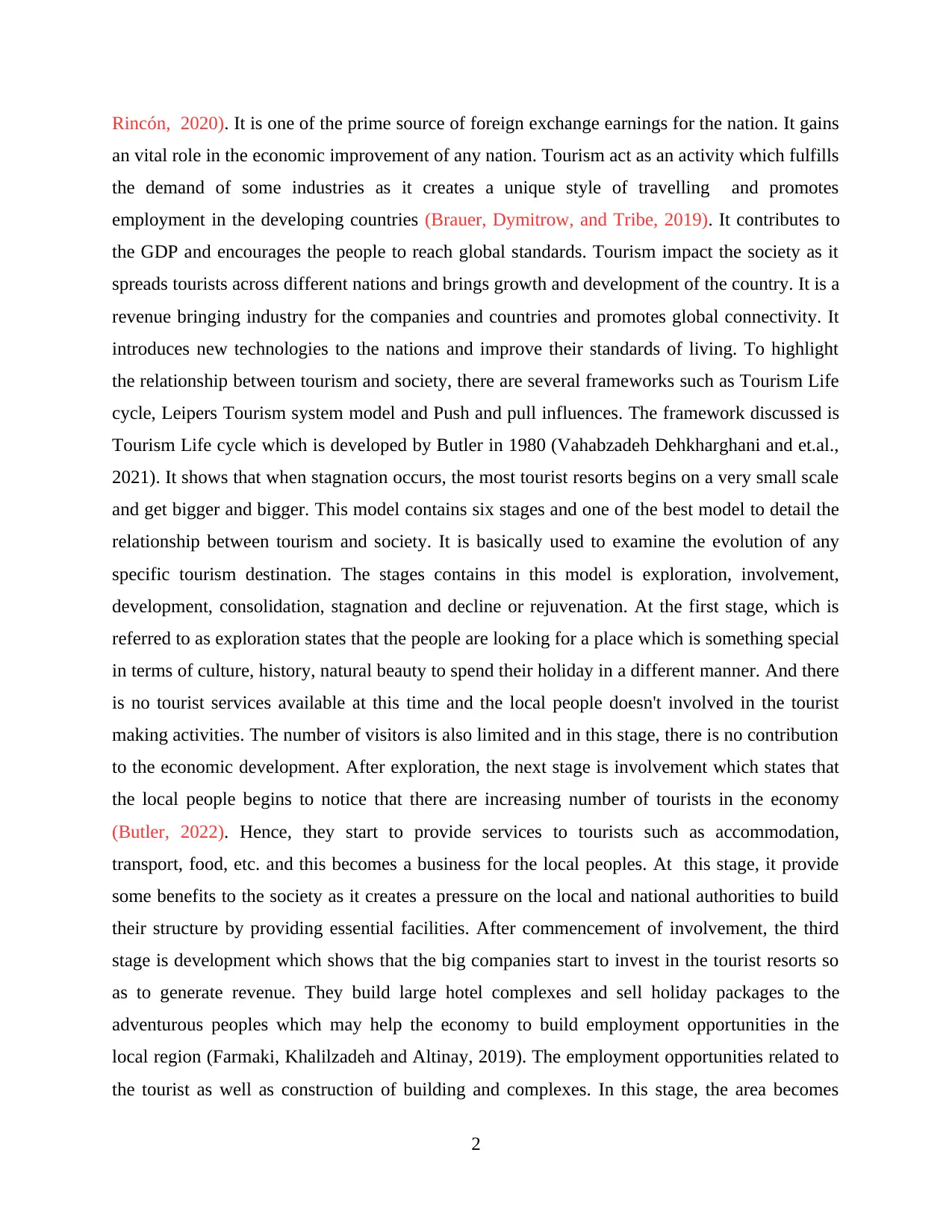
Rincón, 2020). It is one of the prime source of foreign exchange earnings for the nation. It gains
an vital role in the economic improvement of any nation. Tourism act as an activity which fulfills
the demand of some industries as it creates a unique style of travelling and promotes
employment in the developing countries (Brauer, Dymitrow, and Tribe, 2019). It contributes to
the GDP and encourages the people to reach global standards. Tourism impact the society as it
spreads tourists across different nations and brings growth and development of the country. It is a
revenue bringing industry for the companies and countries and promotes global connectivity. It
introduces new technologies to the nations and improve their standards of living. To highlight
the relationship between tourism and society, there are several frameworks such as Tourism Life
cycle, Leipers Tourism system model and Push and pull influences. The framework discussed is
Tourism Life cycle which is developed by Butler in 1980 (Vahabzadeh Dehkharghani and et.al.,
2021). It shows that when stagnation occurs, the most tourist resorts begins on a very small scale
and get bigger and bigger. This model contains six stages and one of the best model to detail the
relationship between tourism and society. It is basically used to examine the evolution of any
specific tourism destination. The stages contains in this model is exploration, involvement,
development, consolidation, stagnation and decline or rejuvenation. At the first stage, which is
referred to as exploration states that the people are looking for a place which is something special
in terms of culture, history, natural beauty to spend their holiday in a different manner. And there
is no tourist services available at this time and the local people doesn't involved in the tourist
making activities. The number of visitors is also limited and in this stage, there is no contribution
to the economic development. After exploration, the next stage is involvement which states that
the local people begins to notice that there are increasing number of tourists in the economy
(Butler, 2022). Hence, they start to provide services to tourists such as accommodation,
transport, food, etc. and this becomes a business for the local peoples. At this stage, it provide
some benefits to the society as it creates a pressure on the local and national authorities to build
their structure by providing essential facilities. After commencement of involvement, the third
stage is development which shows that the big companies start to invest in the tourist resorts so
as to generate revenue. They build large hotel complexes and sell holiday packages to the
adventurous peoples which may help the economy to build employment opportunities in the
local region (Farmaki, Khalilzadeh and Altinay, 2019). The employment opportunities related to
the tourist as well as construction of building and complexes. In this stage, the area becomes
2
an vital role in the economic improvement of any nation. Tourism act as an activity which fulfills
the demand of some industries as it creates a unique style of travelling and promotes
employment in the developing countries (Brauer, Dymitrow, and Tribe, 2019). It contributes to
the GDP and encourages the people to reach global standards. Tourism impact the society as it
spreads tourists across different nations and brings growth and development of the country. It is a
revenue bringing industry for the companies and countries and promotes global connectivity. It
introduces new technologies to the nations and improve their standards of living. To highlight
the relationship between tourism and society, there are several frameworks such as Tourism Life
cycle, Leipers Tourism system model and Push and pull influences. The framework discussed is
Tourism Life cycle which is developed by Butler in 1980 (Vahabzadeh Dehkharghani and et.al.,
2021). It shows that when stagnation occurs, the most tourist resorts begins on a very small scale
and get bigger and bigger. This model contains six stages and one of the best model to detail the
relationship between tourism and society. It is basically used to examine the evolution of any
specific tourism destination. The stages contains in this model is exploration, involvement,
development, consolidation, stagnation and decline or rejuvenation. At the first stage, which is
referred to as exploration states that the people are looking for a place which is something special
in terms of culture, history, natural beauty to spend their holiday in a different manner. And there
is no tourist services available at this time and the local people doesn't involved in the tourist
making activities. The number of visitors is also limited and in this stage, there is no contribution
to the economic development. After exploration, the next stage is involvement which states that
the local people begins to notice that there are increasing number of tourists in the economy
(Butler, 2022). Hence, they start to provide services to tourists such as accommodation,
transport, food, etc. and this becomes a business for the local peoples. At this stage, it provide
some benefits to the society as it creates a pressure on the local and national authorities to build
their structure by providing essential facilities. After commencement of involvement, the third
stage is development which shows that the big companies start to invest in the tourist resorts so
as to generate revenue. They build large hotel complexes and sell holiday packages to the
adventurous peoples which may help the economy to build employment opportunities in the
local region (Farmaki, Khalilzadeh and Altinay, 2019). The employment opportunities related to
the tourist as well as construction of building and complexes. In this stage, the area becomes
2
Paraphrase This Document
Need a fresh take? Get an instant paraphrase of this document with our AI Paraphraser
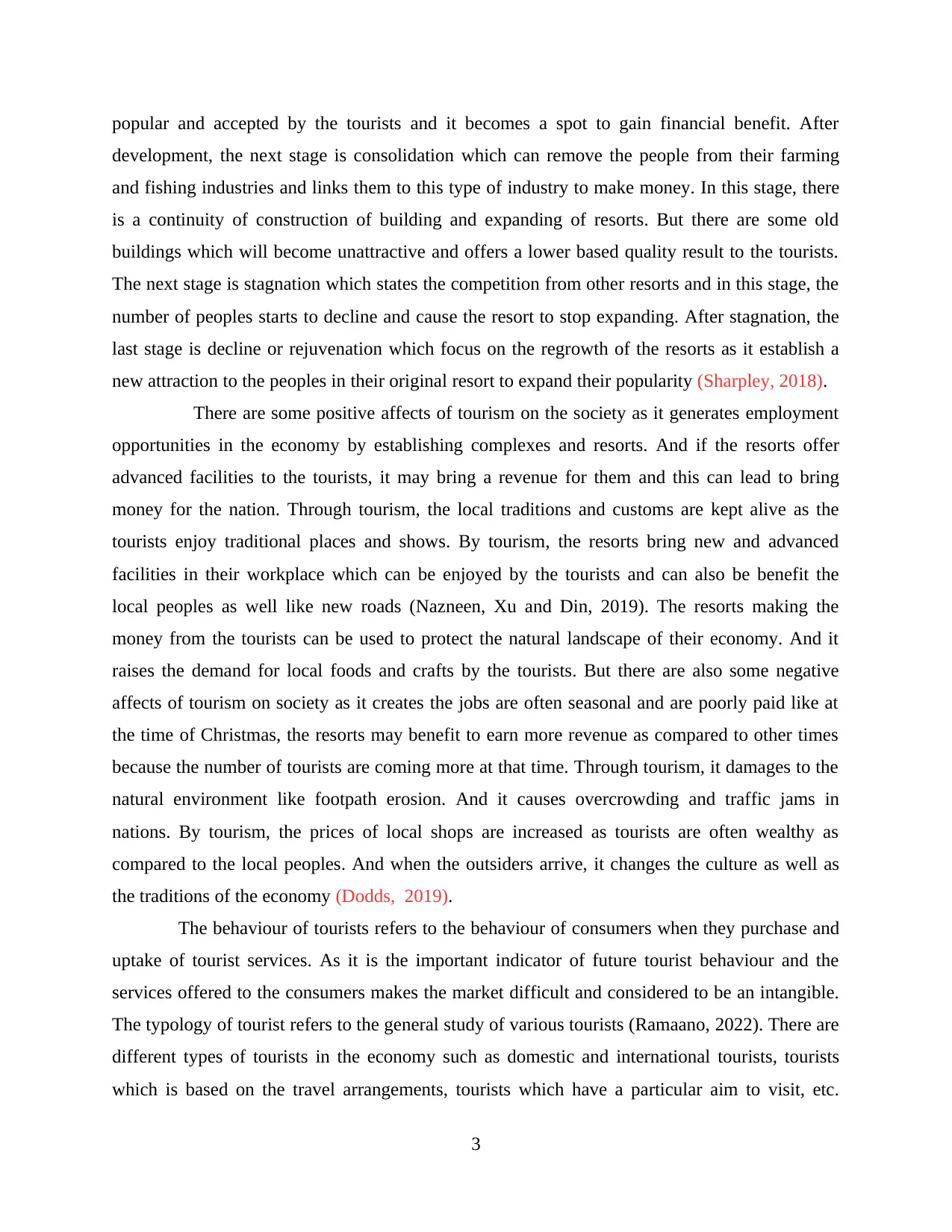
popular and accepted by the tourists and it becomes a spot to gain financial benefit. After
development, the next stage is consolidation which can remove the people from their farming
and fishing industries and links them to this type of industry to make money. In this stage, there
is a continuity of construction of building and expanding of resorts. But there are some old
buildings which will become unattractive and offers a lower based quality result to the tourists.
The next stage is stagnation which states the competition from other resorts and in this stage, the
number of peoples starts to decline and cause the resort to stop expanding. After stagnation, the
last stage is decline or rejuvenation which focus on the regrowth of the resorts as it establish a
new attraction to the peoples in their original resort to expand their popularity (Sharpley, 2018).
There are some positive affects of tourism on the society as it generates employment
opportunities in the economy by establishing complexes and resorts. And if the resorts offer
advanced facilities to the tourists, it may bring a revenue for them and this can lead to bring
money for the nation. Through tourism, the local traditions and customs are kept alive as the
tourists enjoy traditional places and shows. By tourism, the resorts bring new and advanced
facilities in their workplace which can be enjoyed by the tourists and can also be benefit the
local peoples as well like new roads (Nazneen, Xu and Din, 2019). The resorts making the
money from the tourists can be used to protect the natural landscape of their economy. And it
raises the demand for local foods and crafts by the tourists. But there are also some negative
affects of tourism on society as it creates the jobs are often seasonal and are poorly paid like at
the time of Christmas, the resorts may benefit to earn more revenue as compared to other times
because the number of tourists are coming more at that time. Through tourism, it damages to the
natural environment like footpath erosion. And it causes overcrowding and traffic jams in
nations. By tourism, the prices of local shops are increased as tourists are often wealthy as
compared to the local peoples. And when the outsiders arrive, it changes the culture as well as
the traditions of the economy (Dodds, 2019).
The behaviour of tourists refers to the behaviour of consumers when they purchase and
uptake of tourist services. As it is the important indicator of future tourist behaviour and the
services offered to the consumers makes the market difficult and considered to be an intangible.
The typology of tourist refers to the general study of various tourists (Ramaano, 2022). There are
different types of tourists in the economy such as domestic and international tourists, tourists
which is based on the travel arrangements, tourists which have a particular aim to visit, etc.
3
development, the next stage is consolidation which can remove the people from their farming
and fishing industries and links them to this type of industry to make money. In this stage, there
is a continuity of construction of building and expanding of resorts. But there are some old
buildings which will become unattractive and offers a lower based quality result to the tourists.
The next stage is stagnation which states the competition from other resorts and in this stage, the
number of peoples starts to decline and cause the resort to stop expanding. After stagnation, the
last stage is decline or rejuvenation which focus on the regrowth of the resorts as it establish a
new attraction to the peoples in their original resort to expand their popularity (Sharpley, 2018).
There are some positive affects of tourism on the society as it generates employment
opportunities in the economy by establishing complexes and resorts. And if the resorts offer
advanced facilities to the tourists, it may bring a revenue for them and this can lead to bring
money for the nation. Through tourism, the local traditions and customs are kept alive as the
tourists enjoy traditional places and shows. By tourism, the resorts bring new and advanced
facilities in their workplace which can be enjoyed by the tourists and can also be benefit the
local peoples as well like new roads (Nazneen, Xu and Din, 2019). The resorts making the
money from the tourists can be used to protect the natural landscape of their economy. And it
raises the demand for local foods and crafts by the tourists. But there are also some negative
affects of tourism on society as it creates the jobs are often seasonal and are poorly paid like at
the time of Christmas, the resorts may benefit to earn more revenue as compared to other times
because the number of tourists are coming more at that time. Through tourism, it damages to the
natural environment like footpath erosion. And it causes overcrowding and traffic jams in
nations. By tourism, the prices of local shops are increased as tourists are often wealthy as
compared to the local peoples. And when the outsiders arrive, it changes the culture as well as
the traditions of the economy (Dodds, 2019).
The behaviour of tourists refers to the behaviour of consumers when they purchase and
uptake of tourist services. As it is the important indicator of future tourist behaviour and the
services offered to the consumers makes the market difficult and considered to be an intangible.
The typology of tourist refers to the general study of various tourists (Ramaano, 2022). There are
different types of tourists in the economy such as domestic and international tourists, tourists
which is based on the travel arrangements, tourists which have a particular aim to visit, etc.
3
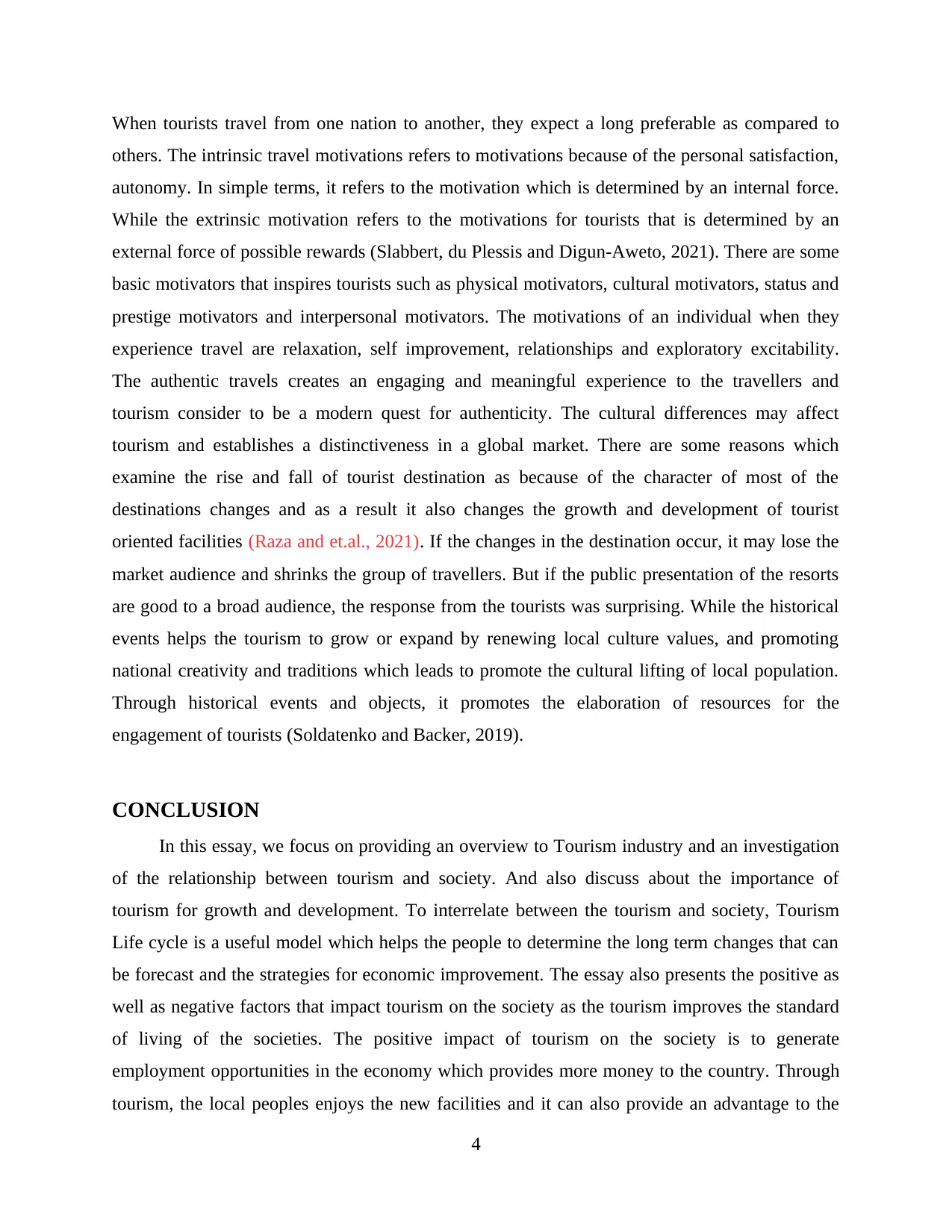
When tourists travel from one nation to another, they expect a long preferable as compared to
others. The intrinsic travel motivations refers to motivations because of the personal satisfaction,
autonomy. In simple terms, it refers to the motivation which is determined by an internal force.
While the extrinsic motivation refers to the motivations for tourists that is determined by an
external force of possible rewards (Slabbert, du Plessis and Digun-Aweto, 2021). There are some
basic motivators that inspires tourists such as physical motivators, cultural motivators, status and
prestige motivators and interpersonal motivators. The motivations of an individual when they
experience travel are relaxation, self improvement, relationships and exploratory excitability.
The authentic travels creates an engaging and meaningful experience to the travellers and
tourism consider to be a modern quest for authenticity. The cultural differences may affect
tourism and establishes a distinctiveness in a global market. There are some reasons which
examine the rise and fall of tourist destination as because of the character of most of the
destinations changes and as a result it also changes the growth and development of tourist
oriented facilities (Raza and et.al., 2021). If the changes in the destination occur, it may lose the
market audience and shrinks the group of travellers. But if the public presentation of the resorts
are good to a broad audience, the response from the tourists was surprising. While the historical
events helps the tourism to grow or expand by renewing local culture values, and promoting
national creativity and traditions which leads to promote the cultural lifting of local population.
Through historical events and objects, it promotes the elaboration of resources for the
engagement of tourists (Soldatenko and Backer, 2019).
CONCLUSION
In this essay, we focus on providing an overview to Tourism industry and an investigation
of the relationship between tourism and society. And also discuss about the importance of
tourism for growth and development. To interrelate between the tourism and society, Tourism
Life cycle is a useful model which helps the people to determine the long term changes that can
be forecast and the strategies for economic improvement. The essay also presents the positive as
well as negative factors that impact tourism on the society as the tourism improves the standard
of living of the societies. The positive impact of tourism on the society is to generate
employment opportunities in the economy which provides more money to the country. Through
tourism, the local peoples enjoys the new facilities and it can also provide an advantage to the
4
others. The intrinsic travel motivations refers to motivations because of the personal satisfaction,
autonomy. In simple terms, it refers to the motivation which is determined by an internal force.
While the extrinsic motivation refers to the motivations for tourists that is determined by an
external force of possible rewards (Slabbert, du Plessis and Digun-Aweto, 2021). There are some
basic motivators that inspires tourists such as physical motivators, cultural motivators, status and
prestige motivators and interpersonal motivators. The motivations of an individual when they
experience travel are relaxation, self improvement, relationships and exploratory excitability.
The authentic travels creates an engaging and meaningful experience to the travellers and
tourism consider to be a modern quest for authenticity. The cultural differences may affect
tourism and establishes a distinctiveness in a global market. There are some reasons which
examine the rise and fall of tourist destination as because of the character of most of the
destinations changes and as a result it also changes the growth and development of tourist
oriented facilities (Raza and et.al., 2021). If the changes in the destination occur, it may lose the
market audience and shrinks the group of travellers. But if the public presentation of the resorts
are good to a broad audience, the response from the tourists was surprising. While the historical
events helps the tourism to grow or expand by renewing local culture values, and promoting
national creativity and traditions which leads to promote the cultural lifting of local population.
Through historical events and objects, it promotes the elaboration of resources for the
engagement of tourists (Soldatenko and Backer, 2019).
CONCLUSION
In this essay, we focus on providing an overview to Tourism industry and an investigation
of the relationship between tourism and society. And also discuss about the importance of
tourism for growth and development. To interrelate between the tourism and society, Tourism
Life cycle is a useful model which helps the people to determine the long term changes that can
be forecast and the strategies for economic improvement. The essay also presents the positive as
well as negative factors that impact tourism on the society as the tourism improves the standard
of living of the societies. The positive impact of tourism on the society is to generate
employment opportunities in the economy which provides more money to the country. Through
tourism, the local peoples enjoys the new facilities and it can also provide an advantage to the
4
⊘ This is a preview!⊘
Do you want full access?
Subscribe today to unlock all pages.

Trusted by 1+ million students worldwide
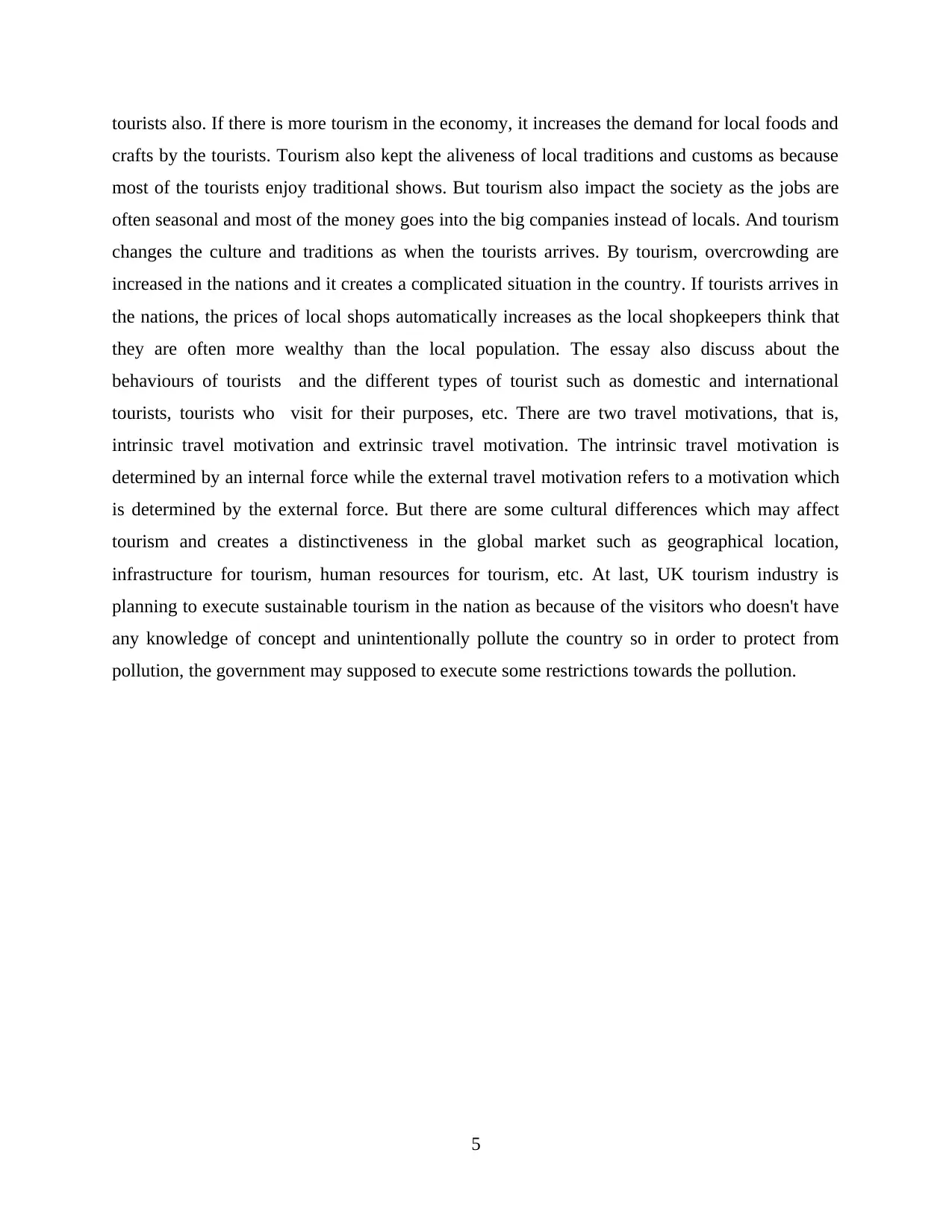
tourists also. If there is more tourism in the economy, it increases the demand for local foods and
crafts by the tourists. Tourism also kept the aliveness of local traditions and customs as because
most of the tourists enjoy traditional shows. But tourism also impact the society as the jobs are
often seasonal and most of the money goes into the big companies instead of locals. And tourism
changes the culture and traditions as when the tourists arrives. By tourism, overcrowding are
increased in the nations and it creates a complicated situation in the country. If tourists arrives in
the nations, the prices of local shops automatically increases as the local shopkeepers think that
they are often more wealthy than the local population. The essay also discuss about the
behaviours of tourists and the different types of tourist such as domestic and international
tourists, tourists who visit for their purposes, etc. There are two travel motivations, that is,
intrinsic travel motivation and extrinsic travel motivation. The intrinsic travel motivation is
determined by an internal force while the external travel motivation refers to a motivation which
is determined by the external force. But there are some cultural differences which may affect
tourism and creates a distinctiveness in the global market such as geographical location,
infrastructure for tourism, human resources for tourism, etc. At last, UK tourism industry is
planning to execute sustainable tourism in the nation as because of the visitors who doesn't have
any knowledge of concept and unintentionally pollute the country so in order to protect from
pollution, the government may supposed to execute some restrictions towards the pollution.
5
crafts by the tourists. Tourism also kept the aliveness of local traditions and customs as because
most of the tourists enjoy traditional shows. But tourism also impact the society as the jobs are
often seasonal and most of the money goes into the big companies instead of locals. And tourism
changes the culture and traditions as when the tourists arrives. By tourism, overcrowding are
increased in the nations and it creates a complicated situation in the country. If tourists arrives in
the nations, the prices of local shops automatically increases as the local shopkeepers think that
they are often more wealthy than the local population. The essay also discuss about the
behaviours of tourists and the different types of tourist such as domestic and international
tourists, tourists who visit for their purposes, etc. There are two travel motivations, that is,
intrinsic travel motivation and extrinsic travel motivation. The intrinsic travel motivation is
determined by an internal force while the external travel motivation refers to a motivation which
is determined by the external force. But there are some cultural differences which may affect
tourism and creates a distinctiveness in the global market such as geographical location,
infrastructure for tourism, human resources for tourism, etc. At last, UK tourism industry is
planning to execute sustainable tourism in the nation as because of the visitors who doesn't have
any knowledge of concept and unintentionally pollute the country so in order to protect from
pollution, the government may supposed to execute some restrictions towards the pollution.
5
Paraphrase This Document
Need a fresh take? Get an instant paraphrase of this document with our AI Paraphraser
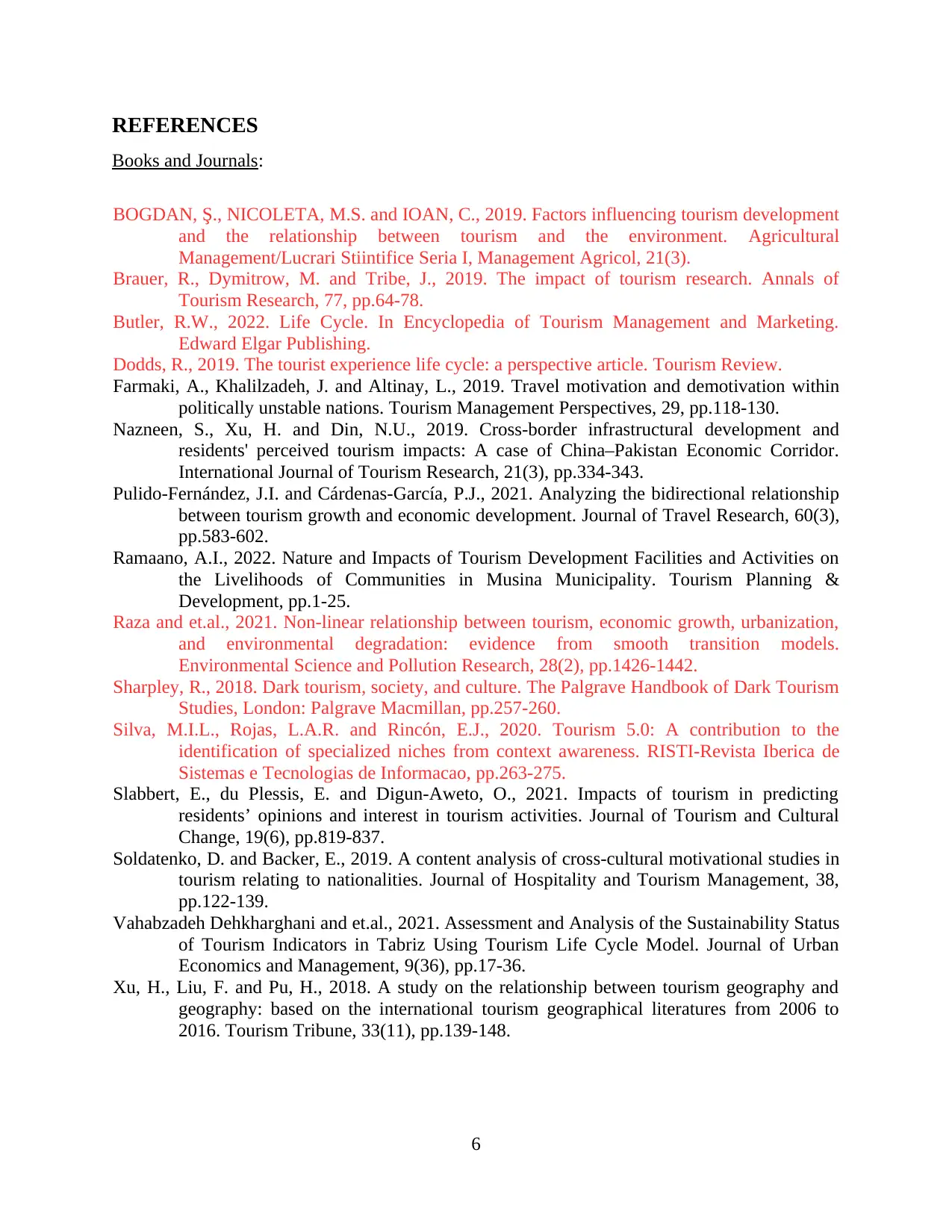
REFERENCES
Books and Journals:
BOGDAN, Ş., NICOLETA, M.S. and IOAN, C., 2019. Factors influencing tourism development
and the relationship between tourism and the environment. Agricultural
Management/Lucrari Stiintifice Seria I, Management Agricol, 21(3).
Brauer, R., Dymitrow, M. and Tribe, J., 2019. The impact of tourism research. Annals of
Tourism Research, 77, pp.64-78.
Butler, R.W., 2022. Life Cycle. In Encyclopedia of Tourism Management and Marketing.
Edward Elgar Publishing.
Dodds, R., 2019. The tourist experience life cycle: a perspective article. Tourism Review.
Farmaki, A., Khalilzadeh, J. and Altinay, L., 2019. Travel motivation and demotivation within
politically unstable nations. Tourism Management Perspectives, 29, pp.118-130.
Nazneen, S., Xu, H. and Din, N.U., 2019. Cross‐border infrastructural development and
residents' perceived tourism impacts: A case of China–Pakistan Economic Corridor.
International Journal of Tourism Research, 21(3), pp.334-343.
Pulido-Fernández, J.I. and Cárdenas-García, P.J., 2021. Analyzing the bidirectional relationship
between tourism growth and economic development. Journal of Travel Research, 60(3),
pp.583-602.
Ramaano, A.I., 2022. Nature and Impacts of Tourism Development Facilities and Activities on
the Livelihoods of Communities in Musina Municipality. Tourism Planning &
Development, pp.1-25.
Raza and et.al., 2021. Non-linear relationship between tourism, economic growth, urbanization,
and environmental degradation: evidence from smooth transition models.
Environmental Science and Pollution Research, 28(2), pp.1426-1442.
Sharpley, R., 2018. Dark tourism, society, and culture. The Palgrave Handbook of Dark Tourism
Studies, London: Palgrave Macmillan, pp.257-260.
Silva, M.I.L., Rojas, L.A.R. and Rincón, E.J., 2020. Tourism 5.0: A contribution to the
identification of specialized niches from context awareness. RISTI-Revista Iberica de
Sistemas e Tecnologias de Informacao, pp.263-275.
Slabbert, E., du Plessis, E. and Digun-Aweto, O., 2021. Impacts of tourism in predicting
residents’ opinions and interest in tourism activities. Journal of Tourism and Cultural
Change, 19(6), pp.819-837.
Soldatenko, D. and Backer, E., 2019. A content analysis of cross-cultural motivational studies in
tourism relating to nationalities. Journal of Hospitality and Tourism Management, 38,
pp.122-139.
Vahabzadeh Dehkharghani and et.al., 2021. Assessment and Analysis of the Sustainability Status
of Tourism Indicators in Tabriz Using Tourism Life Cycle Model. Journal of Urban
Economics and Management, 9(36), pp.17-36.
Xu, H., Liu, F. and Pu, H., 2018. A study on the relationship between tourism geography and
geography: based on the international tourism geographical literatures from 2006 to
2016. Tourism Tribune, 33(11), pp.139-148.
6
Books and Journals:
BOGDAN, Ş., NICOLETA, M.S. and IOAN, C., 2019. Factors influencing tourism development
and the relationship between tourism and the environment. Agricultural
Management/Lucrari Stiintifice Seria I, Management Agricol, 21(3).
Brauer, R., Dymitrow, M. and Tribe, J., 2019. The impact of tourism research. Annals of
Tourism Research, 77, pp.64-78.
Butler, R.W., 2022. Life Cycle. In Encyclopedia of Tourism Management and Marketing.
Edward Elgar Publishing.
Dodds, R., 2019. The tourist experience life cycle: a perspective article. Tourism Review.
Farmaki, A., Khalilzadeh, J. and Altinay, L., 2019. Travel motivation and demotivation within
politically unstable nations. Tourism Management Perspectives, 29, pp.118-130.
Nazneen, S., Xu, H. and Din, N.U., 2019. Cross‐border infrastructural development and
residents' perceived tourism impacts: A case of China–Pakistan Economic Corridor.
International Journal of Tourism Research, 21(3), pp.334-343.
Pulido-Fernández, J.I. and Cárdenas-García, P.J., 2021. Analyzing the bidirectional relationship
between tourism growth and economic development. Journal of Travel Research, 60(3),
pp.583-602.
Ramaano, A.I., 2022. Nature and Impacts of Tourism Development Facilities and Activities on
the Livelihoods of Communities in Musina Municipality. Tourism Planning &
Development, pp.1-25.
Raza and et.al., 2021. Non-linear relationship between tourism, economic growth, urbanization,
and environmental degradation: evidence from smooth transition models.
Environmental Science and Pollution Research, 28(2), pp.1426-1442.
Sharpley, R., 2018. Dark tourism, society, and culture. The Palgrave Handbook of Dark Tourism
Studies, London: Palgrave Macmillan, pp.257-260.
Silva, M.I.L., Rojas, L.A.R. and Rincón, E.J., 2020. Tourism 5.0: A contribution to the
identification of specialized niches from context awareness. RISTI-Revista Iberica de
Sistemas e Tecnologias de Informacao, pp.263-275.
Slabbert, E., du Plessis, E. and Digun-Aweto, O., 2021. Impacts of tourism in predicting
residents’ opinions and interest in tourism activities. Journal of Tourism and Cultural
Change, 19(6), pp.819-837.
Soldatenko, D. and Backer, E., 2019. A content analysis of cross-cultural motivational studies in
tourism relating to nationalities. Journal of Hospitality and Tourism Management, 38,
pp.122-139.
Vahabzadeh Dehkharghani and et.al., 2021. Assessment and Analysis of the Sustainability Status
of Tourism Indicators in Tabriz Using Tourism Life Cycle Model. Journal of Urban
Economics and Management, 9(36), pp.17-36.
Xu, H., Liu, F. and Pu, H., 2018. A study on the relationship between tourism geography and
geography: based on the international tourism geographical literatures from 2006 to
2016. Tourism Tribune, 33(11), pp.139-148.
6
1 out of 8
Related Documents
Your All-in-One AI-Powered Toolkit for Academic Success.
+13062052269
info@desklib.com
Available 24*7 on WhatsApp / Email
![[object Object]](/_next/static/media/star-bottom.7253800d.svg)
Unlock your academic potential
Copyright © 2020–2025 A2Z Services. All Rights Reserved. Developed and managed by ZUCOL.




